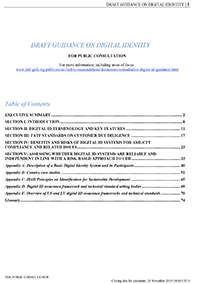The Financial Action Task Force (FATF) is developing guidance to clarify how digital identity (digital ID) systems can be used for customer due diligence (CDD). The Draft guidance on digital id for public consultation intends to help governments, financial institutions and other relevant entities apply a risk-based approach to the use of digital ID for CDD.
The FATF is consulting private sector stakeholders before finalising the guidance. We welcome your views on the areas of focus below, in addition to specific proposals to the text of the guidance. We primarily seek views from banks, virtual asset service providers and other regulated entities, but also welcome views from authorities.
The FATF will revise the text of the guidance and particular sections (for example – Appendix B that contains case studies) in parallel to the public consultation.
| | Areas of focus
- Are there any specific money laundering / terrorist financing risks, that arise from the use of digital identity systems for CDD, other than those already mentioned in Section IV of the guidance?
If so, how can they be addressed and by whom? Are there specific opportunities for combatting money laundering / terrorist financing that are not already mentioned in the guidance?
- What is the role of digital ID systems in ongoing due diligence or transaction monitoring?
a. What information do you capture under authentication at on-boarding and during authorisation for account access? Who captures this data?
b. Is the authentication data you capture relevant to ongoing anti-money laundering and counter terrorist financing due diligence and/or transaction monitoring? If yes, how?
- How can digital ID systems support financial inclusion?
a. How can digital ID systems with different assurance levels for identity proofing/enrolment and/or authentication be used to implement tiered CDD, allowing clients a range of account functionalities depending on the extent of CDD performed, and particularly in situations of lower risk? Please provide any practical examples.
b. Have you adopted lower assurance levels for identity proofing to support financial inclusion? What additional measures do you apply to mitigate risks? Please provide any practical examples.
c. How can progressive CDD via digital ID systems aid financial inclusion (i.e. establishing greater confidence in a customer’s identity over time)?
- Does the use of digital ID systems for CDD raise distinct issues for implementing the FATF record-keeping requirements?
a. What records do you keep when you use digital ID systems for CDD?
b. What are the challenges in meeting record-keeping requirements when you use digital ID systems for CDD?
c. If you keep different records when using digital ID systems for on-boarding, does this impact other anti-money laundering and counter-terrorist financing measures (for example ongoing due diligence or transaction monitoring)?
Please provide your response to FATF.Publicconsultation@fatf-gafi.org with subject-line “Comments of [author] on the draft Digital ID Guidance”, by 29 November 2019 (18:00 UTC). (The public consultation is now closed)
|
While submitting your response, please indicate the name of your organisation, the nature of your business (financial institution or designated non-financial business and profession, digital ID service provider, certification or assurance body, industry group, others), and your contact details. You may insert any specific drafting proposals directly in the attached text of the draft guidance in tracked changes. The contact information you provide will be used for the purpose of this public consultation only. The FATF will not share this information with third parties without your consent.
At this stage, the FATF has not approved he current draft of the guidance. The FATF will make further amendments at its February 2020 meetings.


 Twitter
Twitter
 Facebook
Facebook
 Instagram
Instagram
 Linkedin
Linkedin
